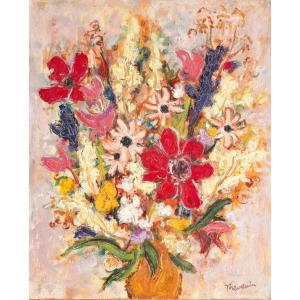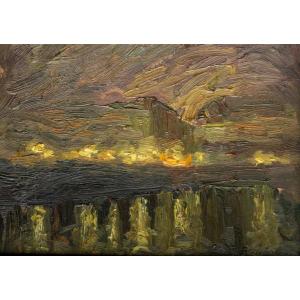This painting by Eugène Brouillard presents a woodland scene dominated by the massive presence of fallen tree trunks in the foreground. These trunks, rendered with thick paint and broad, energetic strokes, structure the composition and lead the viewer’s gaze toward the background, where upright trees stand with their slender branches intertwining in an almost chaotic atmosphere. The color palette is rich in browns, deep greens, and touches of ochre, creating a strong contrast with the orange and blue hues of the sky in the distance.
Brouillard’s technique, characterized by the use of a palette knife and heavy impasto, gives the whole scene a highly expressive, almost sculptural texture. The forms are suggested rather than precisely defined, lending the scene a dimension that is both realistic and dreamlike. The fallen trunks evoke the power of nature and the passage of time, while the tangle of branches conveys a sense of movement and life.
This painting perfectly illustrates Brouillard’s modernity: he moves away from classical landscape painting to focus on material, light, and the energy of the gesture, transforming nature into a vibrant, emotionally charged space.
Born in Croix-Rousse in 1870, Brouillard began his career as a designer in a lace factory. At just 14 years old, he worked for Dognin, a French industrial company specializing in the manufacture of tulle and lace. In 1890, at the age of 19, he exhibited for the first time at the Salon des Beaux-Arts in Lyon, presenting a charcoal drawing titled Sous-bois, depicting a landscape of Tassin, with the Izeron river in the foreground. In 1898, he partnered with Bruiset to open a drawing studio, but the latter passed away the following year. Brouillard then became close to the Routier-Chavan company, which led to numerous commissions and the need to hire workers to meet demand.
In 1922, he received the commission to decorate the banquet hall of the 3rd arrondissement Town Hall in Lyon with 18 large panels, creating a fresco titled Lyon, Cité des Eaux, measuring 66 meters in length.
Brouillard’s favorite subjects were landscapes with particular atmospheres—sunsets, misty scenes, riverbanks, as well as views from the Tête d'Or park. He had a particular fondness for still lifes. He also painted Lyonnais landscapes and scenes from the Dombes, featuring mysterious ponds and marshes, bordered by lush vegetation and twisted, deformed trees.
His inspiration came from nature as well as from the works of Poussin, the Barbizon painters, especially Camille Corot, and local artists like Baudin, Ravier, and Vernay. Describing his technique, he referred to it as "cuisine," full of unexpected and personal recipes. By around 1912, his works began to show the characteristic grays of his palette, and he started painting with a palette knife, using large, broad strokes to add texture and depth to his landscapes.




























 Le Magazine de PROANTIC
Le Magazine de PROANTIC TRÉSORS Magazine
TRÉSORS Magazine Rivista Artiquariato
Rivista Artiquariato